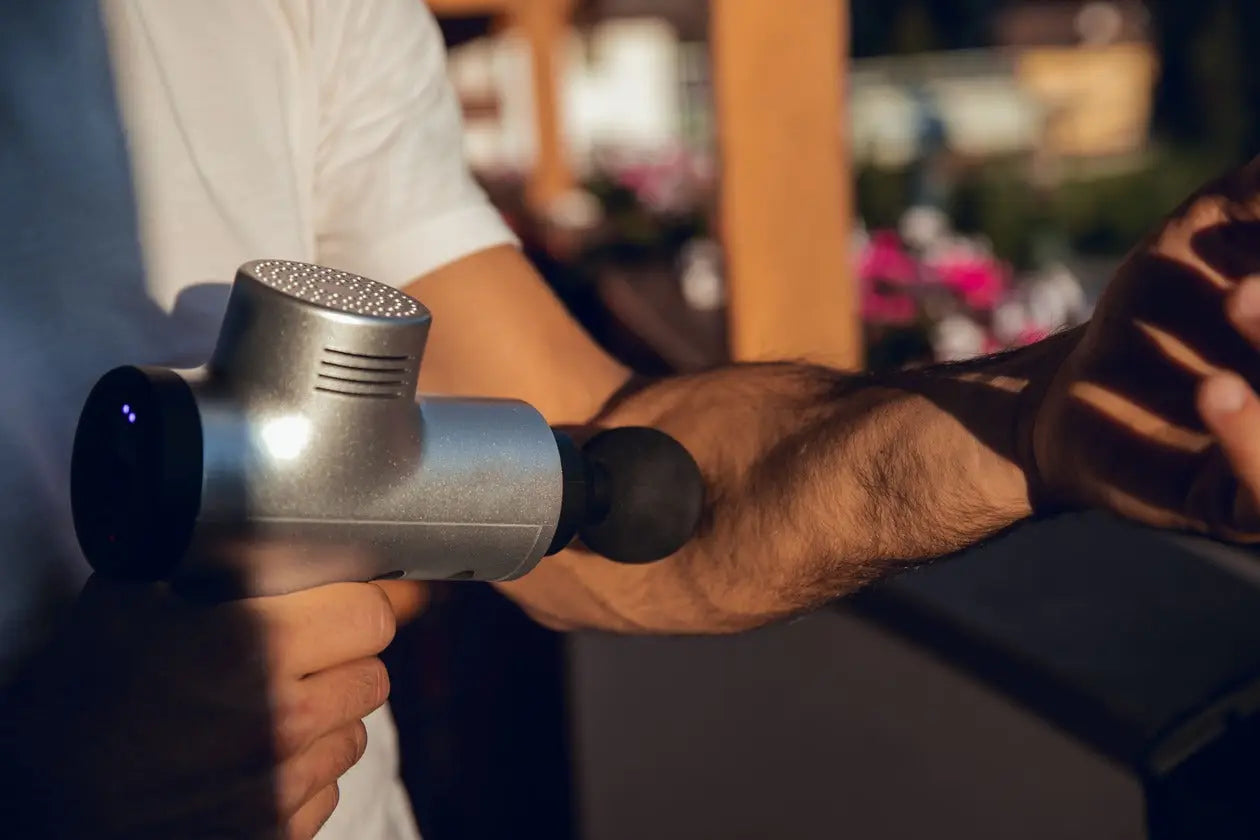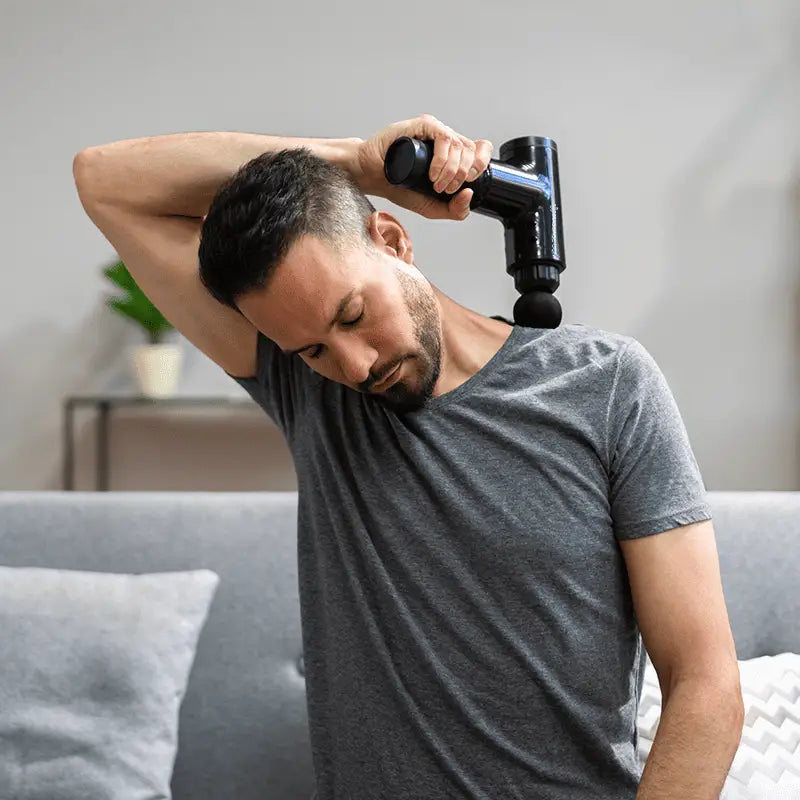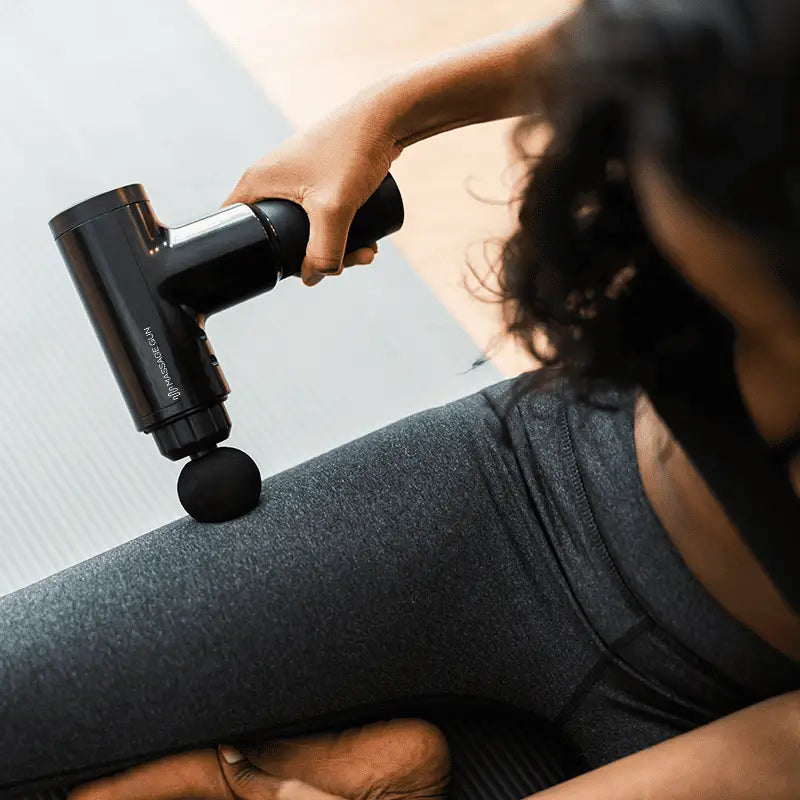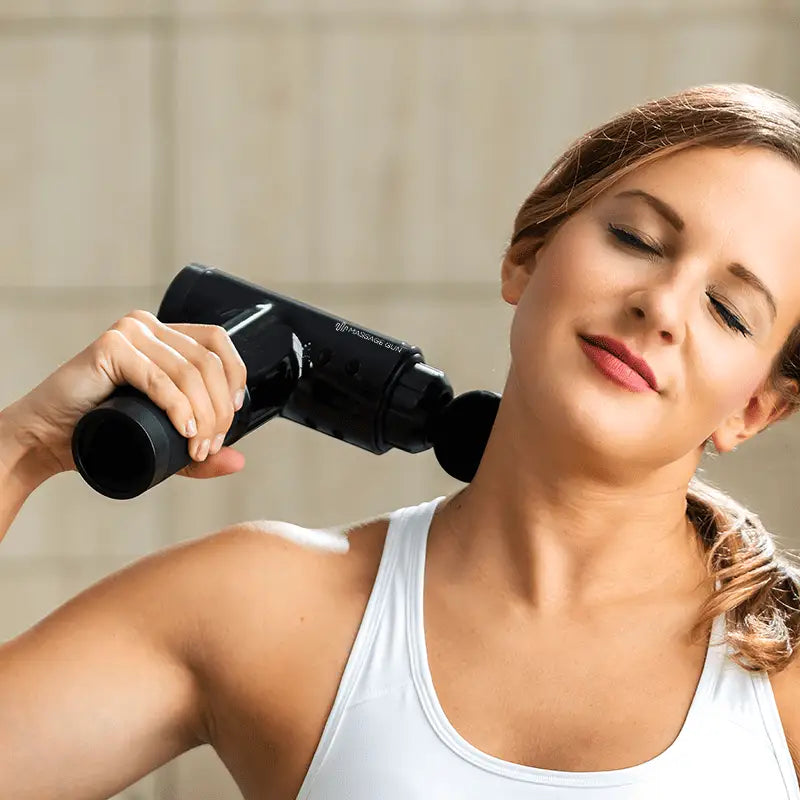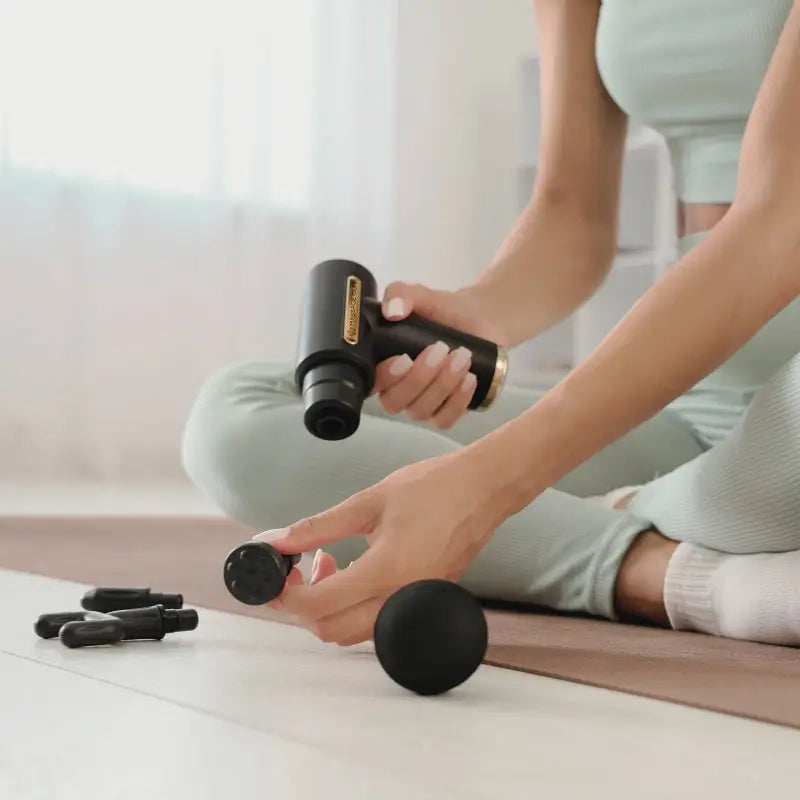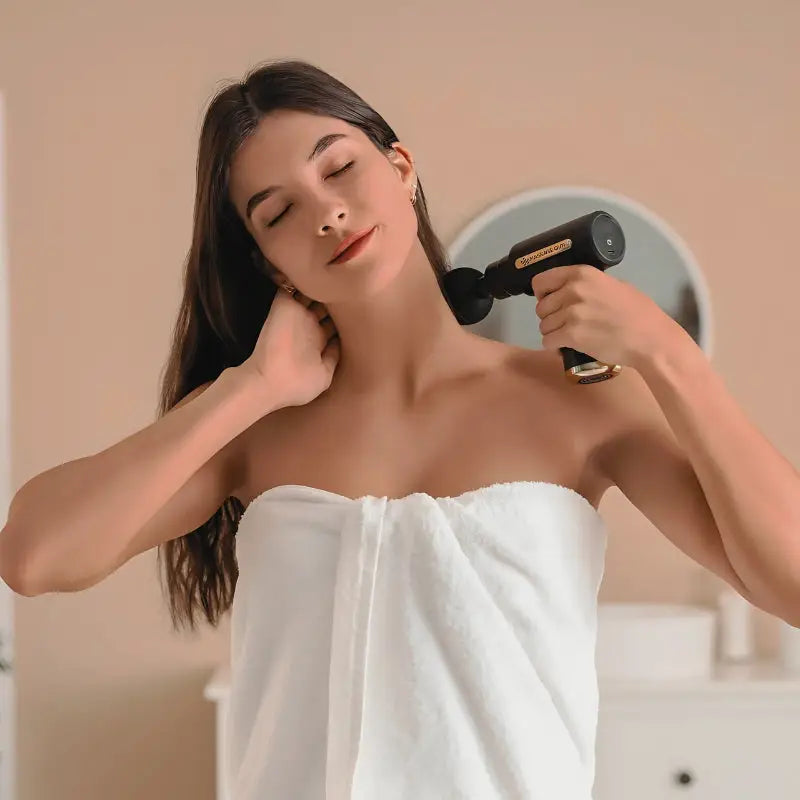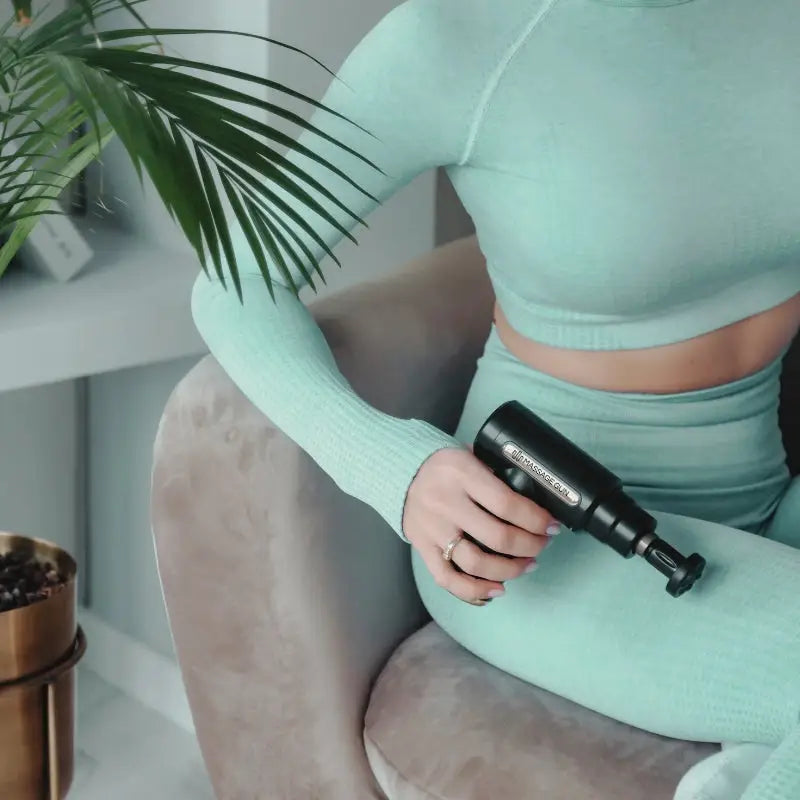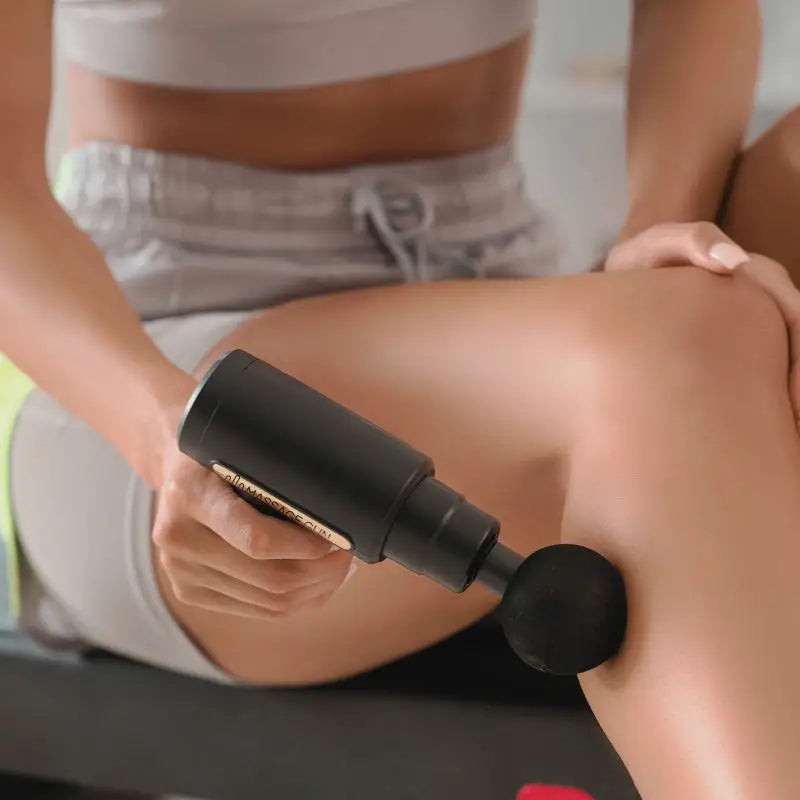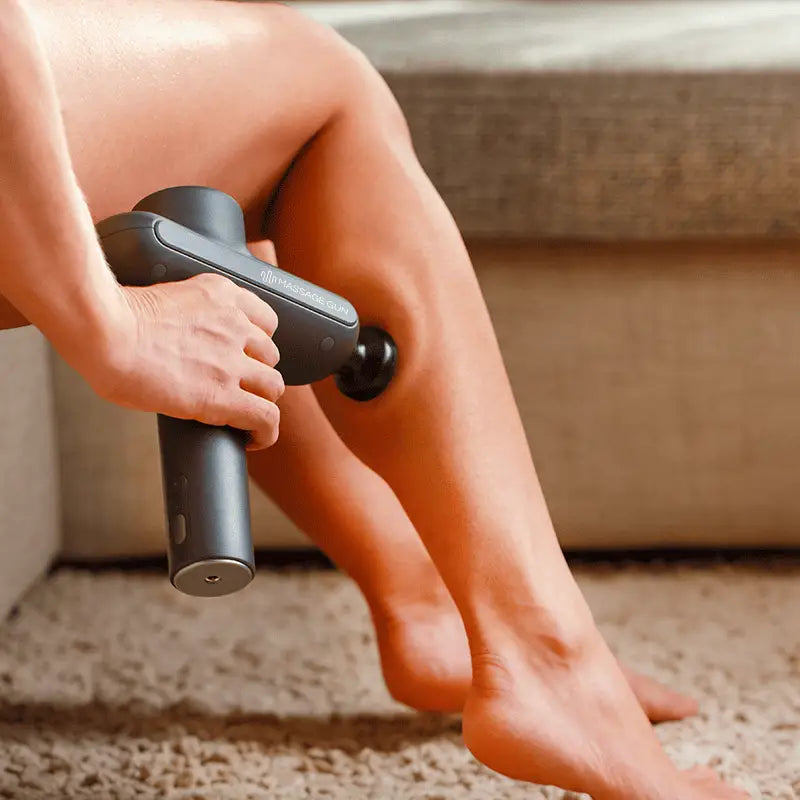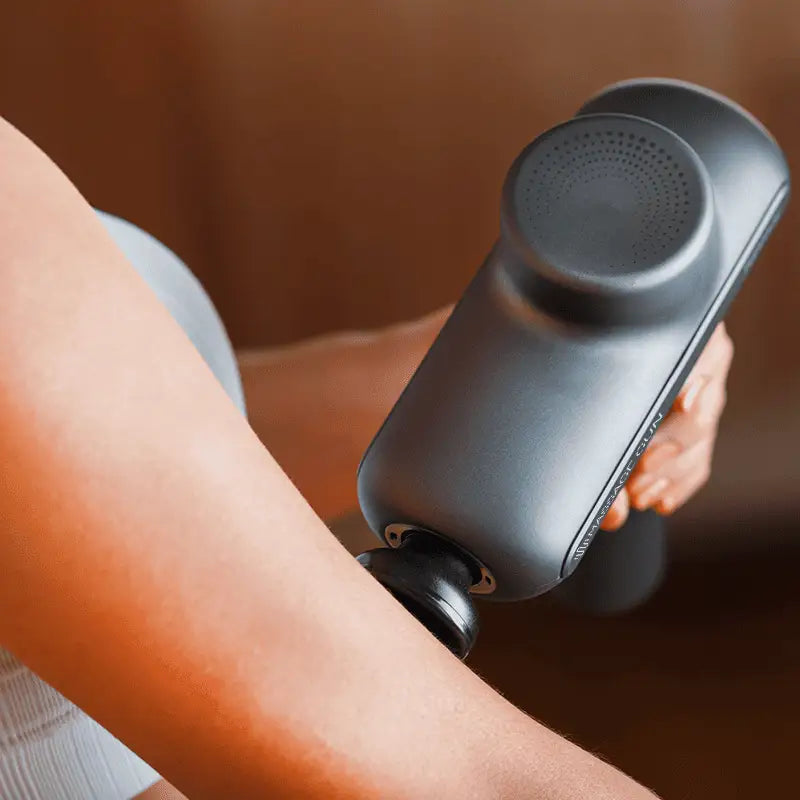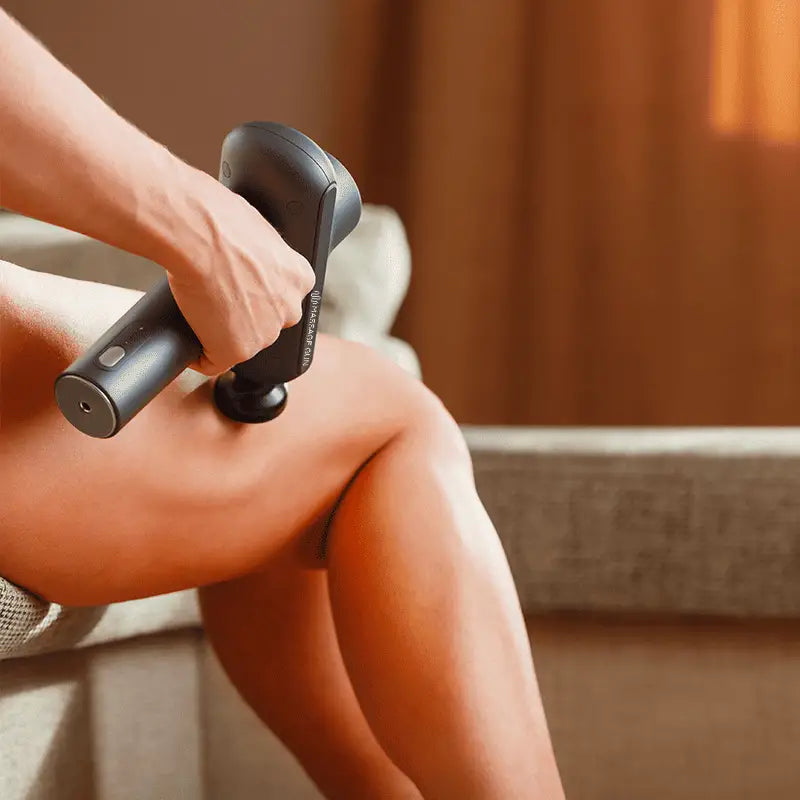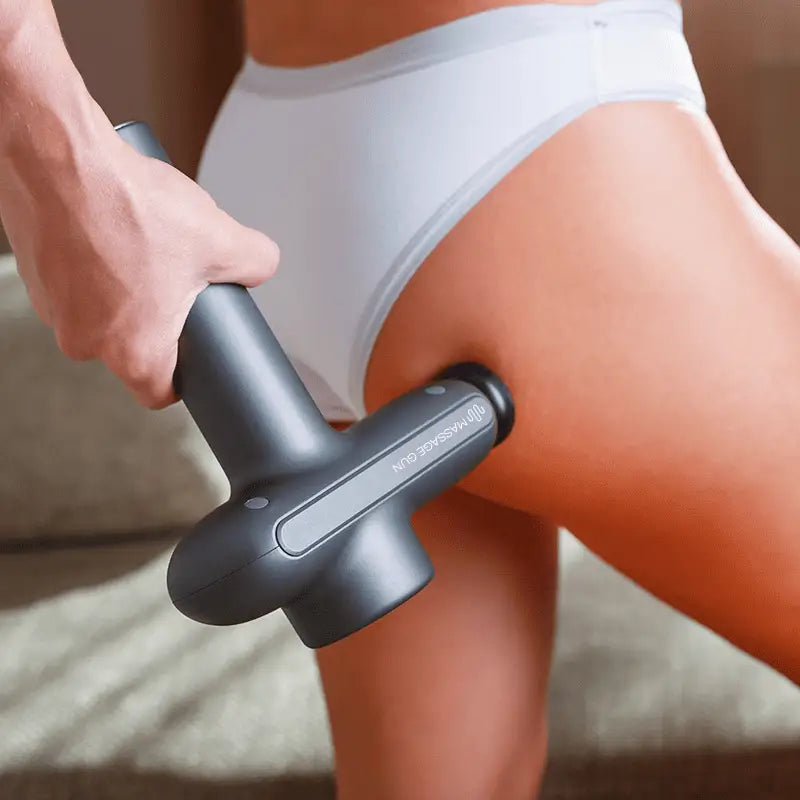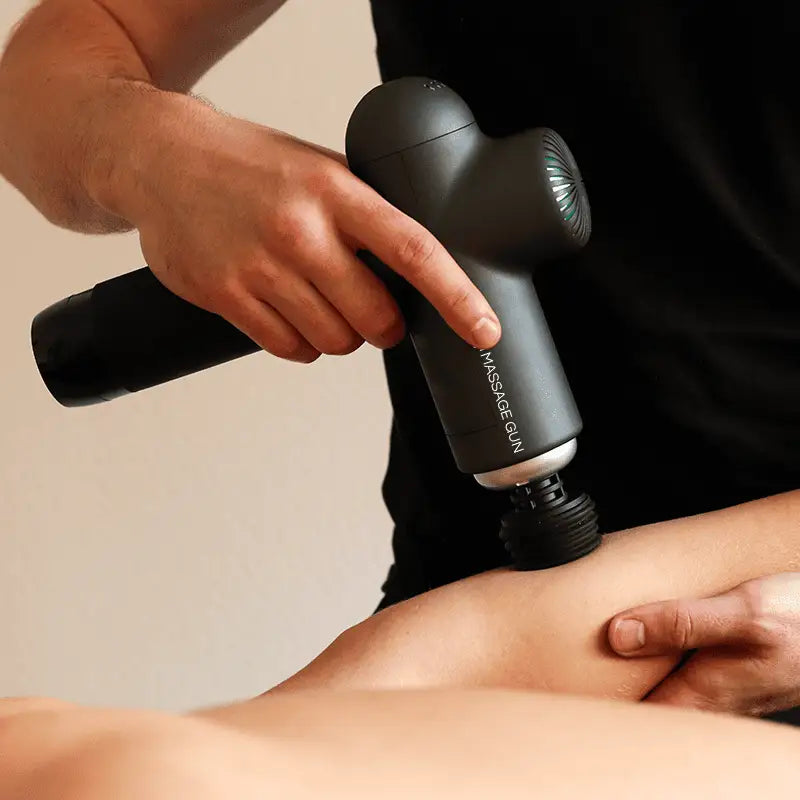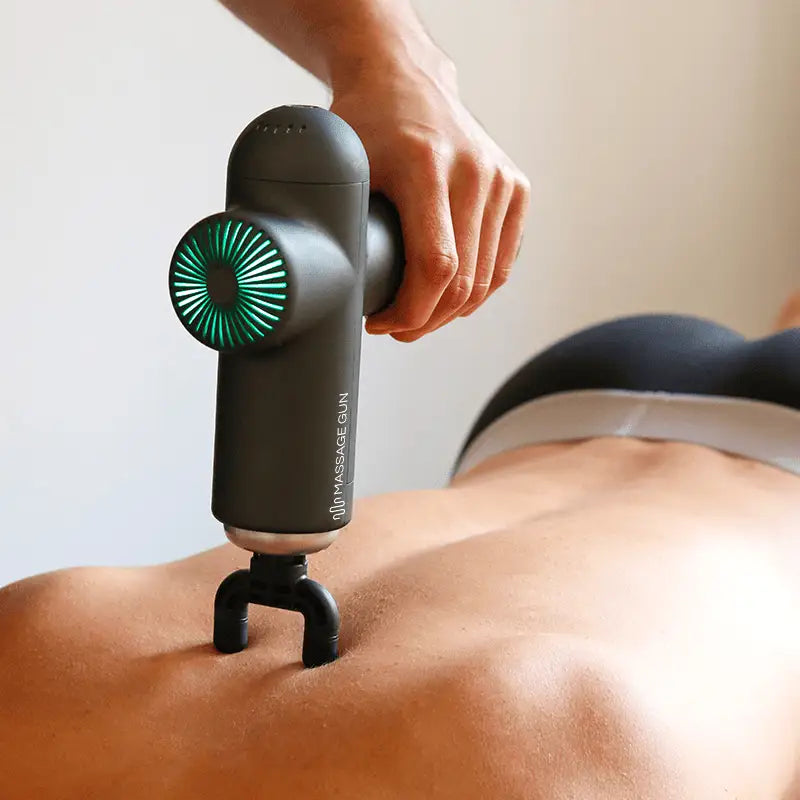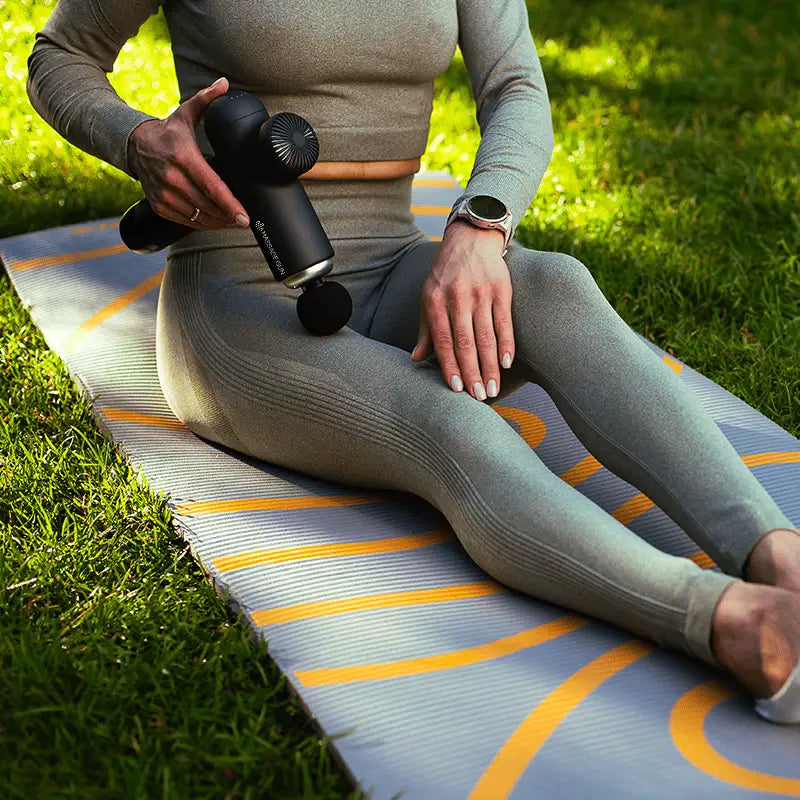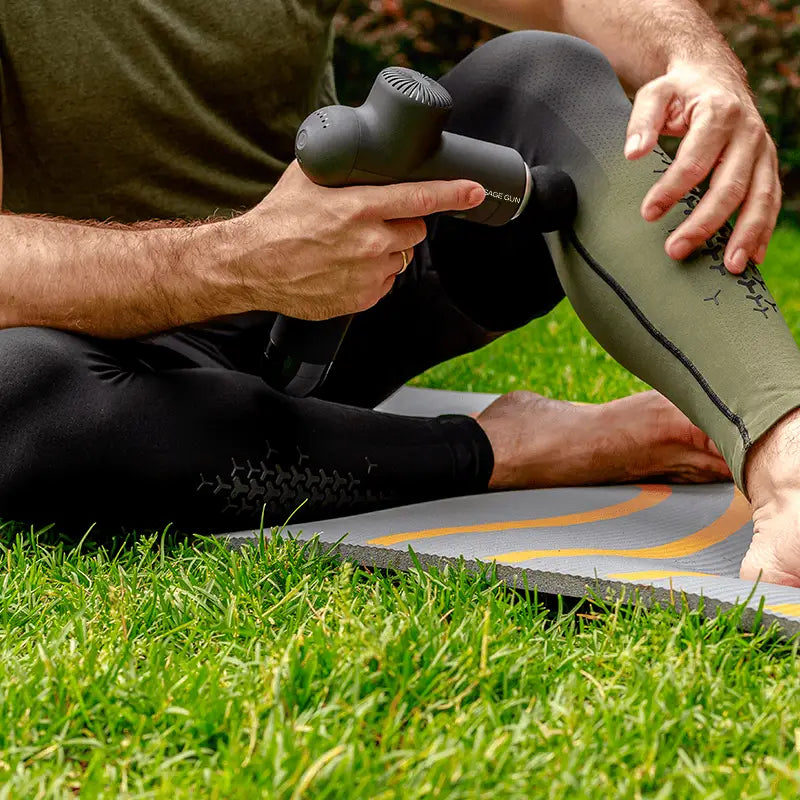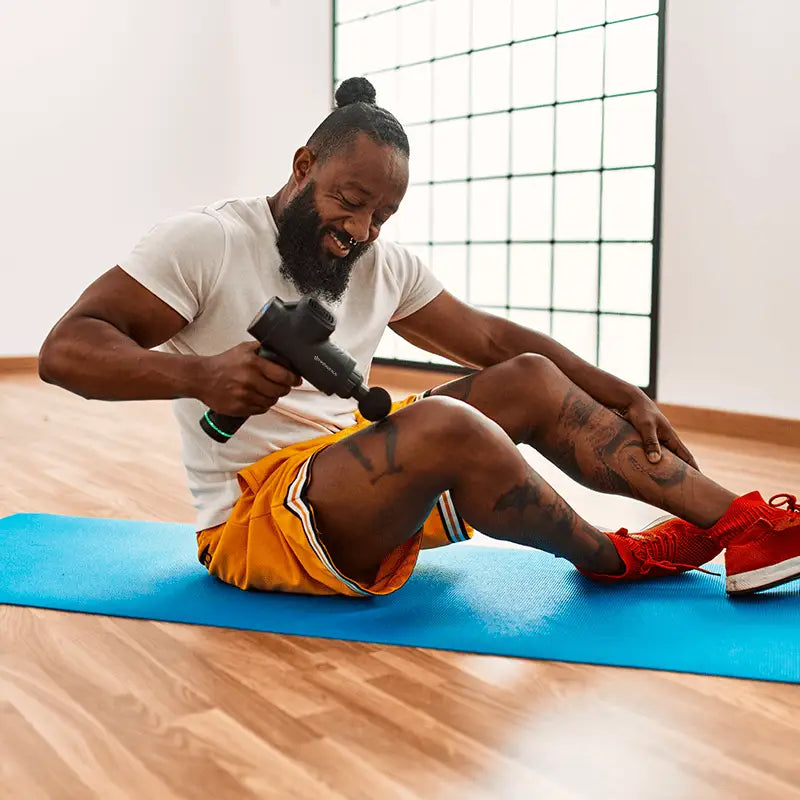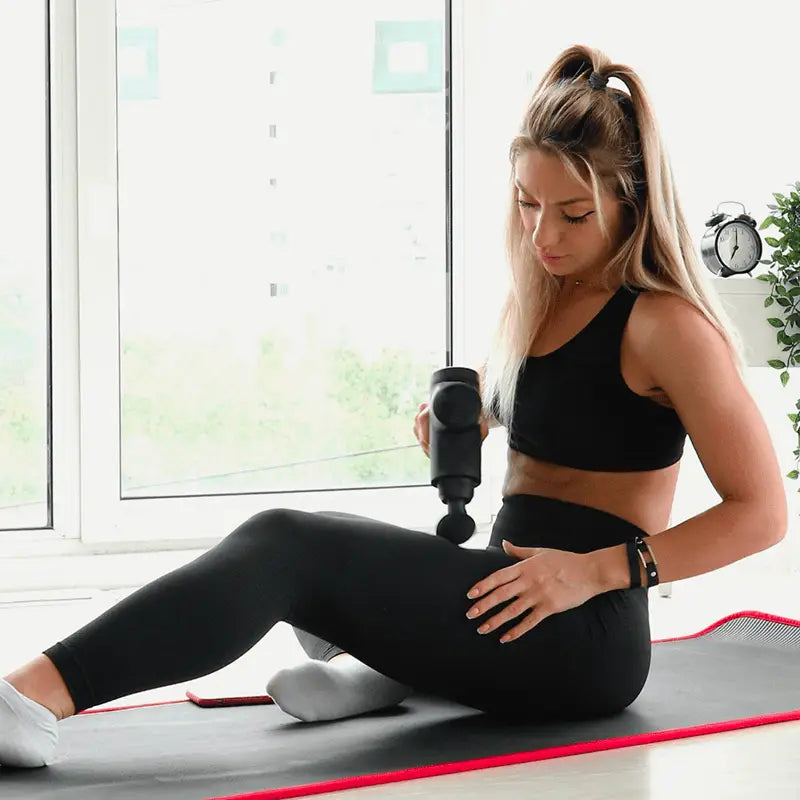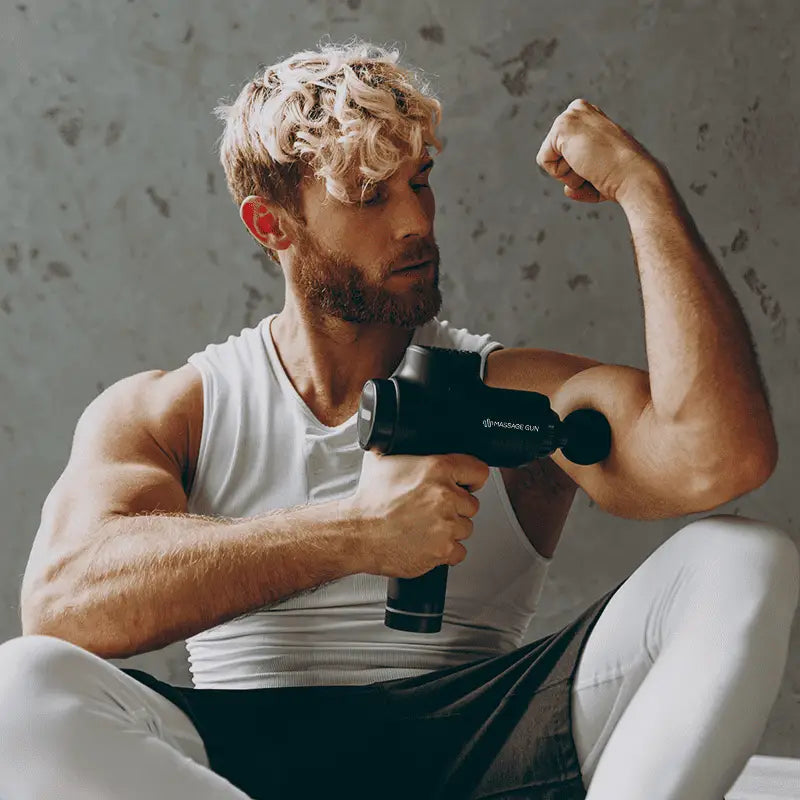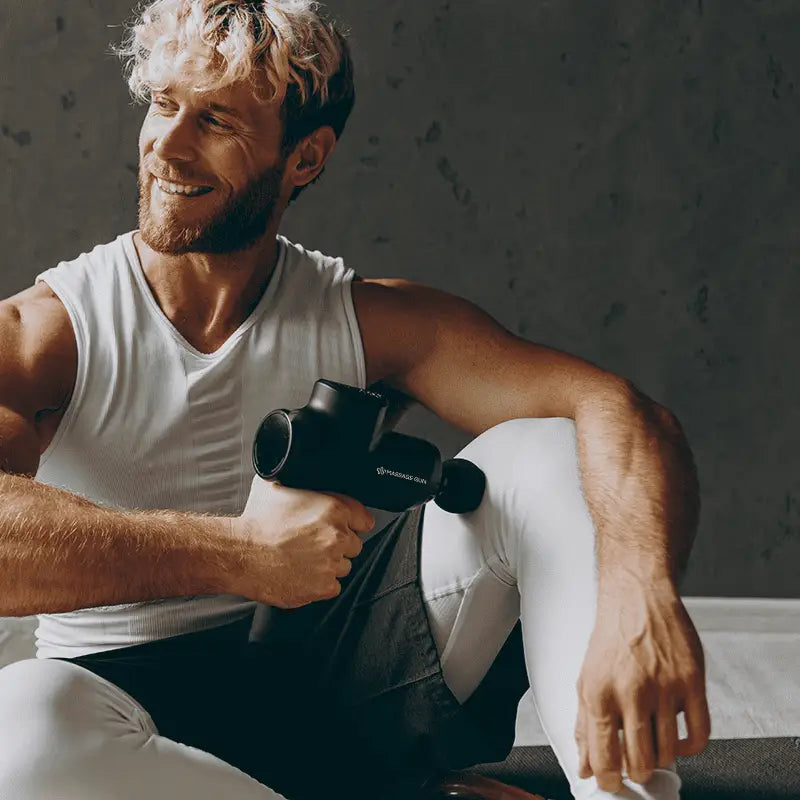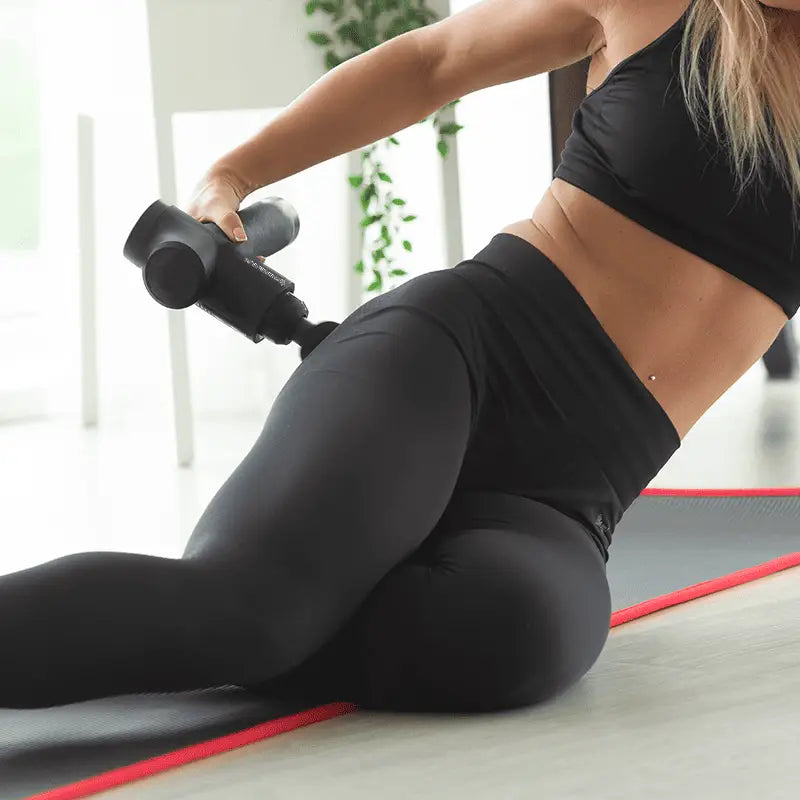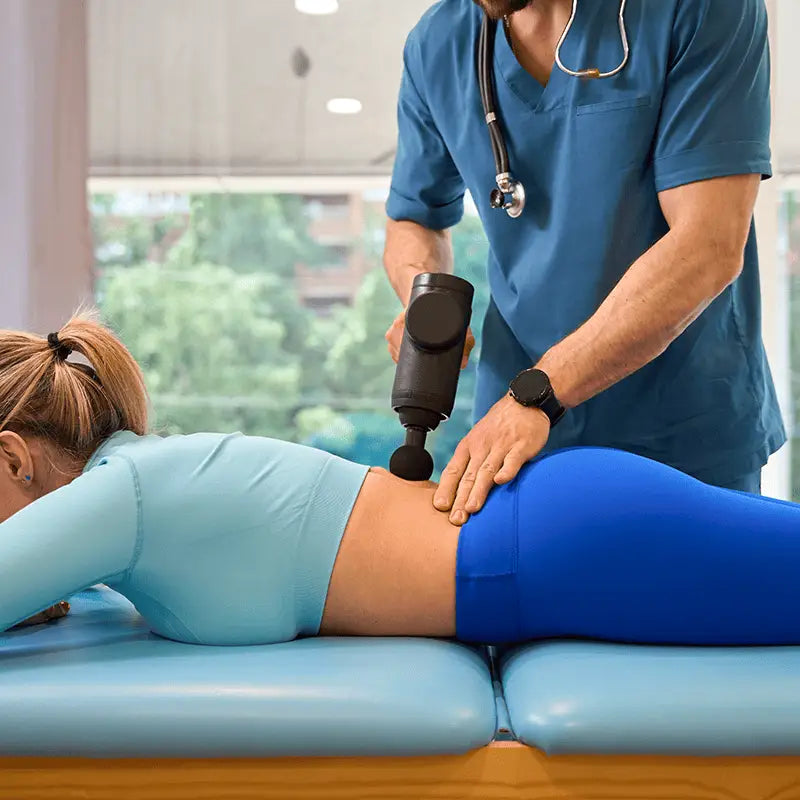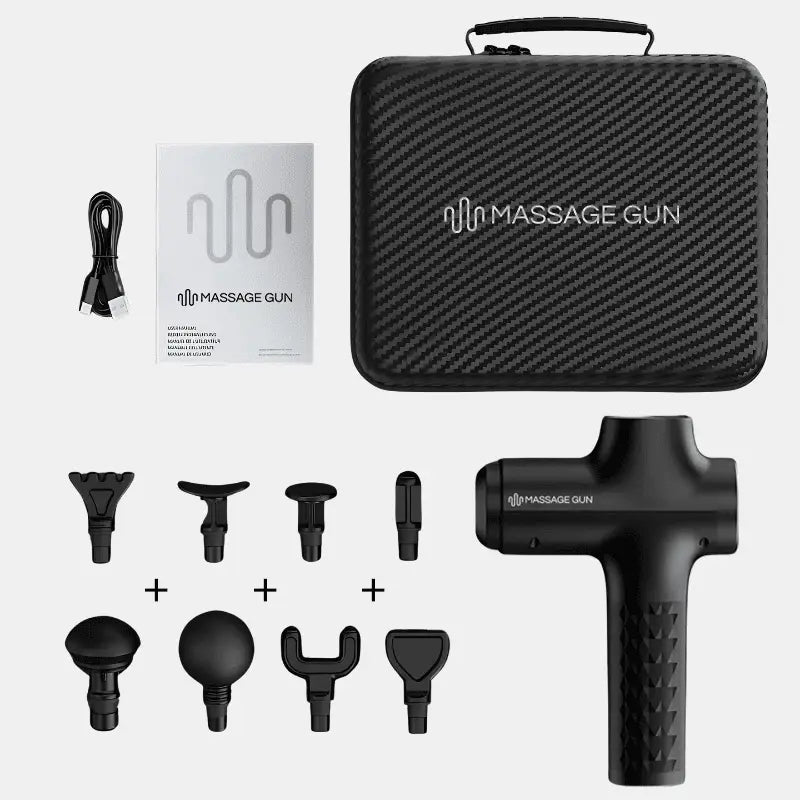Les nœuds musculaires sont une source fréquente d'inconfort, souvent associés à des tensions musculaires, au stress ou à une sollicitation excessive. De nombreuses personnes souffrant de douleurs musculaires ont recours aux pistolets de massage pour soulager ces nœuds. Mais ces pistolets sont-ils vraiment efficaces ?
Les pistolets de massage, qui utilisent la thérapie par percussion, exercent une pression rapide et concentrée sur les tissus musculaires pour cibler les zones tendues. Cela permet de détendre les fibres musculaires, d'améliorer la circulation sanguine et de favoriser la récupération musculaire . Cet article explore comment les pistolets de massage peuvent aider à soulager les nœuds musculaires, leurs bienfaits et comment les utiliser correctement pour des résultats optimaux.
Comprendre les nœuds musculaires et leurs causes
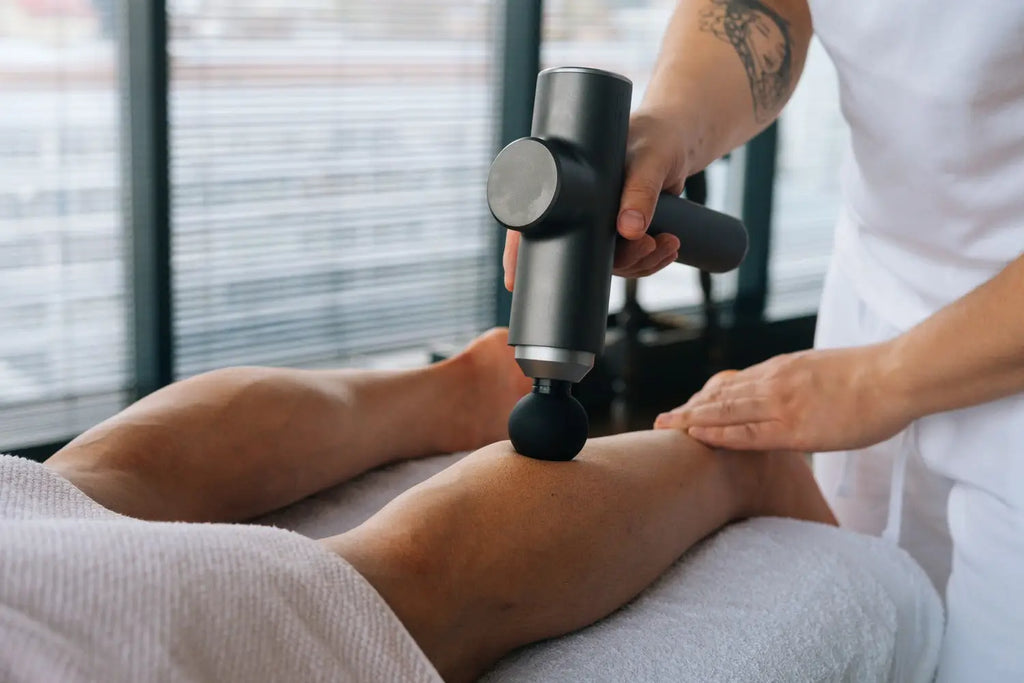
Que sont les nœuds musculaires ?
Les nœuds musculaires, également appelés points gâchettes myofasciaux, sont des zones tendues et douloureuses au sein des fibres musculaires, qui peuvent provoquer une gêne et limiter l'amplitude des mouvements. Ces nœuds se forment lorsque les muscles se contractent sans se relâcher complètement , créant une zone tendue et sensible.
On les ressent souvent comme de petites bosses sous la peau. Les nœuds musculaires sont plus susceptibles de se développer dans des zones comme le cou, les épaules et le dos, où la raideur musculaire due au stress ou à une mauvaise posture est fréquente.
Causes courantes des nœuds musculaires
Les nœuds musculaires peuvent se développer pour diverses raisons, notamment une position assise prolongée, une mauvaise posture ou des mouvements répétitifs. Ils sont également associés au stress, qui peut provoquer des contractions musculaires au fil du temps.
Les personnes qui ne pratiquent pas d'activité physique régulière sont plus susceptibles de développer des nœuds. Ces nœuds peuvent provoquer des douleurs et limiter les mouvements, entraînant courbatures et raideurs musculaires s'ils ne sont pas traités correctement.
Pourquoi les nœuds musculaires provoquent-ils de l’inconfort ?
Les nœuds musculaires peuvent provoquer des douleurs en limitant le flux sanguin vers la zone affectée, ce qui entraîne une accumulation d’acide lactique et d’autres déchets dans le tissu musculaire.
Ce manque de circulation entraîne un resserrement supplémentaire des fibres musculaires, ce qui accroît l'inconfort et les tensions. À long terme, les nœuds musculaires non traités peuvent engendrer des douleurs ou un inconfort à long terme, rendant les activités quotidiennes difficiles.
Comment fonctionnent les pistolets de massage pour les nœuds musculaires ?
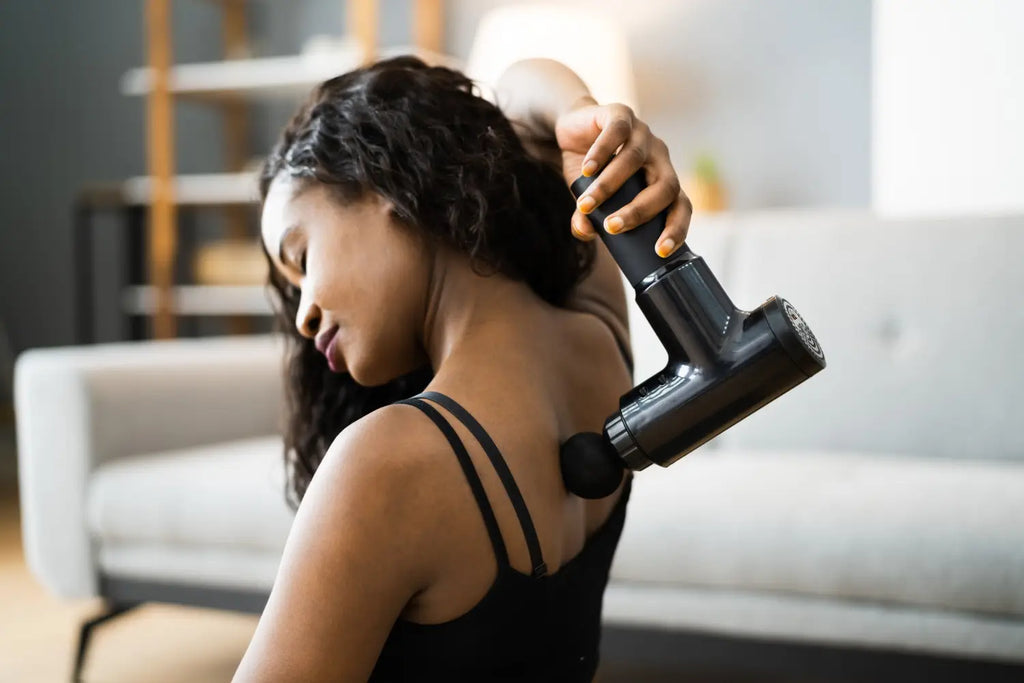
La science derrière la thérapie par percussion
Les pistolets de massage fonctionnent grâce à la thérapie par percussion, une technique qui consiste à appliquer une pression rapide et répétitive en profondeur dans le tissu musculaire. Cela stimule la circulation sanguine et aide à dissoudre les adhérences musculaires , ou tissus cicatriciels, à l'origine des nœuds.
En appliquant un pistolet de massage sur un nœud musculaire, vous ciblez directement la zone affectée, améliorant ainsi la circulation et libérant les tensions. La thérapie par percussion est également bénéfique pour la récupération musculaire globale, contribuant à réduire les courbatures et les raideurs.
Comment la thérapie par percussion cible les nœuds musculaires ?
La thérapie par percussion est particulièrement efficace pour traiter les nœuds musculaires, car elle agit en profondeur. Les impulsions rapides délivrées par l'appareil rompent les fibres musculaires tendues et libèrent les points gâchettes myofasciaux responsables des nœuds.
Avec la bonne technique, les pistolets de massage peuvent soulager rapidement les tensions et favoriser la récupération musculaire. L'action percutante prévient également la formation de nœuds en maintenant les muscles détendus et en favorisant une bonne circulation sanguine.
Les pistolets de massage sont-ils efficaces pour tous les types de nœuds ?
Les pistolets de massage sont très efficaces pour la plupart des groupes musculaires, en particulier sur les zones étendues comme le dos, les épaules et les cuisses. Cependant, pour les zones plus petites ou plus délicates comme le cou, il est conseillé de veiller à ne pas exercer une pression excessive.
L'utilisation d'un accessoire plus souple ou d'une vitesse plus faible peut aider à soulager les nœuds musculaires dans ces zones. Bien que les pistolets de massage puissent être très efficaces, ils doivent être utilisés avec une technique appropriée pour éviter de provoquer des douleurs ou un inconfort musculaires supplémentaires.
Bonnes pratiques pour utiliser un pistolet de massage sur les nœuds

Choisir le bon accessoire pour les nœuds musculaires
Différents nœuds musculaires nécessitent différents accessoires. Pour un massage des tissus profonds ou des nœuds particulièrement tenaces, l'accessoire en forme de balle ou de fourchette est idéal, car il cible des points précis et précis. Pour les groupes musculaires plus importants, comme le dos ou les cuisses, l'accessoire rond ou à boule peut être plus adapté.
Un accessoire adapté garantit une utilisation efficace du pistolet de massage, procurant un soulagement sans provoquer d'irritation supplémentaire. Le massage par rouleau de mousse peut également compléter l'utilisation du pistolet de massage pour soulager les tensions.
Les réglages optimaux de vitesse et de pression
Les réglages de vitesse et de pression d'un pistolet de massage sont essentiels pour obtenir les meilleurs résultats. Pour les nœuds musculaires, il est recommandé de commencer par une vitesse lente et d'augmenter progressivement l'intensité . Appliquer une pression trop forte et trop rapidement peut aggraver les courbatures.
Une pression modérée associée à une vitesse moyenne est souvent idéale pour cibler les nœuds serrés. Laissez le pistolet de massage faire son travail et évitez d'appuyer trop fort pour éviter les ecchymoses ou d'autres douleurs musculaires.
Combien de temps et à quelle fréquence utiliser un pistolet de massage pour les nœuds ?
Lorsque vous utilisez un pistolet de massage pour les nœuds, il est important de ne pas en abuser. Consacrer environ 1 à 2 minutes sur chaque nœud , en se concentrant sur un groupe musculaire à la fois, suffit à détendre les muscles tendus.
Des séances régulières, environ 2 à 3 fois par semaine, peuvent aider à prévenir la formation de nœuds et favoriser la récupération musculaire. Au fil du temps, intégrer la thérapie par pistolet de massage à votre routine peut préserver la santé de vos muscles et réduire le risque de réapparition des tensions.
Avantages de l'utilisation d'un pistolet de massage pour les nœuds musculaires
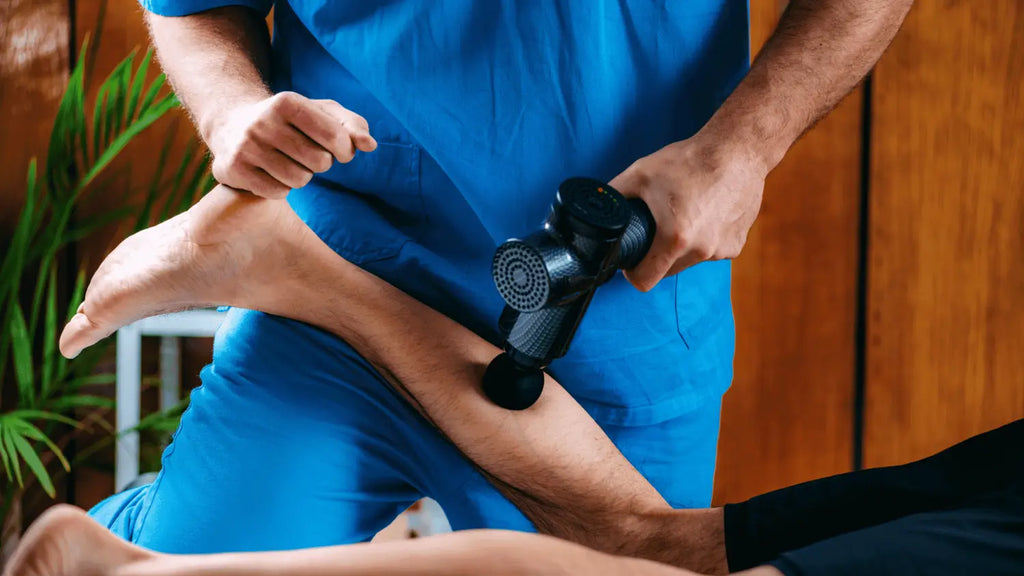
Soulagement immédiat des tensions musculaires
L'un des principaux avantages d'un pistolet de massage est le soulagement immédiat des tensions musculaires. En augmentant le flux sanguin vers la zone affectée, un pistolet de massage peut contribuer à réduire la raideur musculaire et à soulager la douleur.
C'est un outil idéal pour les sportifs et les personnes souffrant de tensions dues à une position assise prolongée. Le soulagement rapide apporté par un pistolet de massage aide à détendre les zones tendues et à restaurer la mobilité.
Mobilité et flexibilité améliorées
Les pistolets de massage contribuent également à une meilleure mobilité et souplesse. En dissolvant les tissus cicatriciels et en améliorant la circulation sanguine, la thérapie par pistolet de massage peut prévenir la tension excessive des fibres musculaires.
Cette mobilité accrue favorise la récupération musculaire après l'entraînement, réduit la douleur et améliore la santé musculaire globale. L'utilisation régulière d'un pistolet de massage permet de détendre les zones tendues et de prévenir l'accumulation de tensions.
Avantages à long terme d'une utilisation régulière
Au fil du temps, l’utilisation régulière d’un pistolet de massage peut entraîner des avantages à long terme tels qu’une meilleure santé musculaire, une meilleure amplitude de mouvement et moins de nœuds musculaires.
En prévenant la contraction musculaire, les pistolets de massage peuvent réduire le risque de douleur ou d'inconfort associé aux tensions musculaires . Ceci est particulièrement utile pour les personnes souffrant de tensions chroniques, car une utilisation régulière peut contribuer à prévenir la réapparition de ces problèmes.
Erreurs courantes à éviter lors de l'utilisation d'un pistolet de massage sur les nœuds
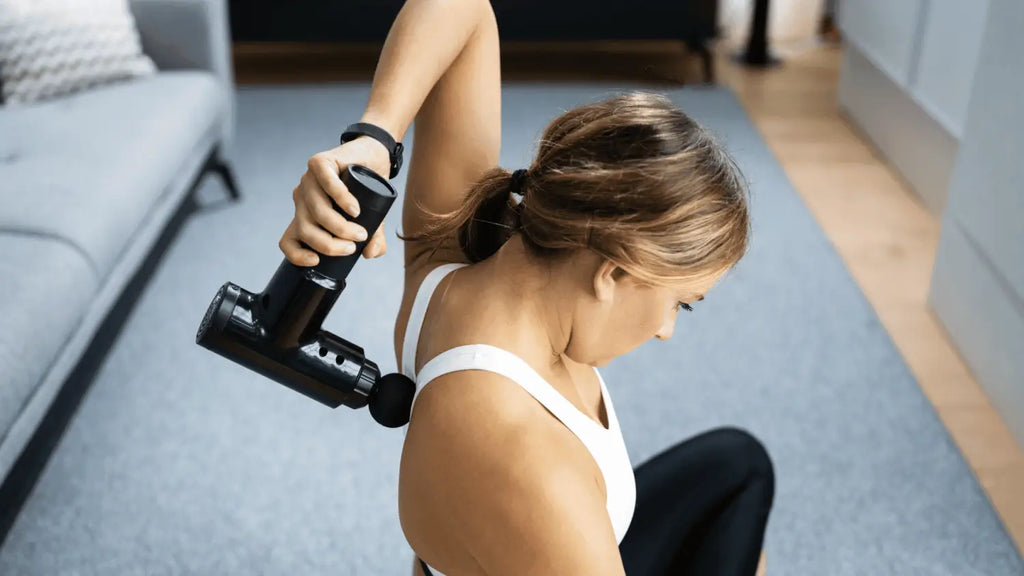
Utiliser un accessoire ou une vitesse incorrecte
Il est important de choisir l'embout adapté à la zone ciblée. Pour les petits nœuds , un embout conique peut être préférable, mais pour les groupes musculaires plus importants, un embout plus souple, comme la tête ronde, est préférable.
Une mauvaise utilisation des accessoires ou des réglages de vitesse peut être plus néfaste que bénéfique, augmentant la douleur au lieu de la soulager. Pour éviter cela, testez différents réglages afin de trouver celui qui convient le mieux à chaque nœud musculaire.
Appliquer trop de pression
L'une des erreurs les plus courantes consiste à exercer une pression excessive lors de l'utilisation d'un pistolet de massage. Même si une pression plus forte peut sembler efficace pour éliminer le nœud , elle peut en réalité provoquer des ecchymoses ou endommager les tissus.
Le meilleur moyen d'éviter ce problème est d'appliquer une pression modérée et de laisser le pistolet de massage agir. N'oubliez pas : pénétrer profondément dans le muscle ne signifie pas pousser trop fort, mais plutôt une technique appropriée.
Utilisation excessive du pistolet de massage
Utiliser un pistolet de massage trop longtemps sur la même zone peut entraîner une fatigue musculaire. L'objectif est de détendre les muscles tendus et de favoriser la récupération, et non de provoquer des courbatures supplémentaires.
Respectez les durées d'utilisation recommandées, généralement de quelques minutes maximum par zone, afin d'éviter toute utilisation excessive. Une utilisation excessive peut également provoquer des tensions musculaires plutôt qu'un soulagement ; il est donc important de laisser à vos muscles le temps de récupérer entre les séances.
Pistolets de massage vs autres méthodes de traitement des nœuds
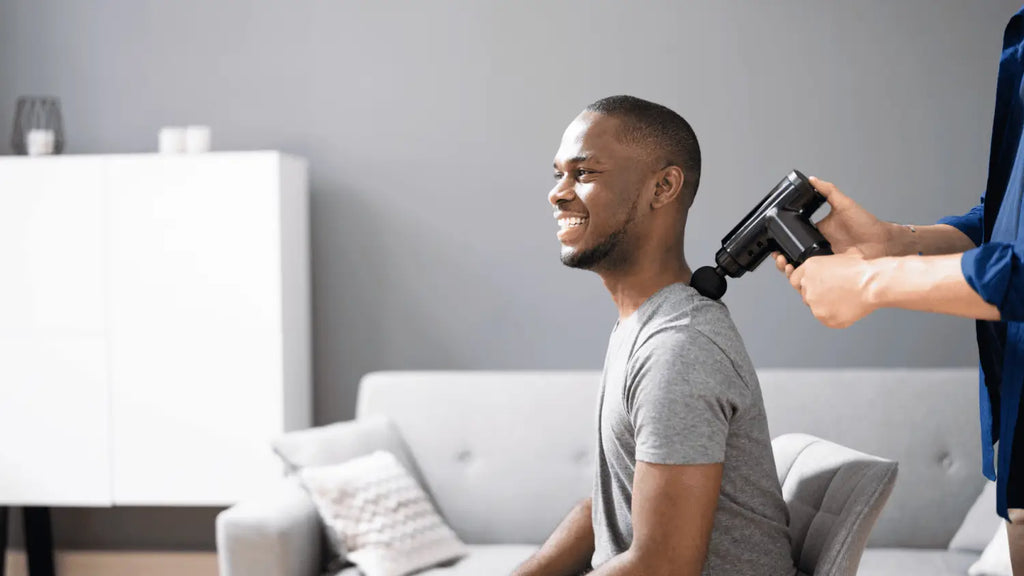
Thérapie par percussion vs. roulement de mousse
Le massage au rouleau de mousse et la thérapie par percussion offrent tous deux des méthodes efficaces pour traiter les nœuds musculaires, mais leurs modes d'action sont différents. Le massage au rouleau de mousse cible des zones plus larges du corps, contribuant ainsi à relâcher les tensions musculaires de manière plus générale.
En revanche, les pistolets de massage procurent un soulagement ciblé, pénétrant profondément dans le muscle pour dénouer des nœuds spécifiques. L'utilisation combinée de ces deux outils offre une approche globale de la récupération musculaire et du soulagement de la douleur.
Pistolets de massage vs massage des tissus profonds
Si le massage des tissus profonds est une méthode éprouvée pour traiter les nœuds musculaires, les pistolets de massage offrent une solution plus pratique au quotidien . Le massage des tissus profonds s'effectue par une pression soutenue pour briser les adhérences musculaires, tandis que les pistolets de massage utilisent des impulsions rapides pour obtenir des résultats similaires.
Bien que les massages professionnels soient très efficaces, l’utilisation régulière d’un pistolet de massage peut aider à maintenir la santé musculaire entre les séances.
Les pistolets de massage peuvent-ils remplacer les méthodes traditionnelles ?
Les pistolets de massage ne doivent pas remplacer complètement les méthodes traditionnelles comme les étirements, la physiothérapie ou le massage des tissus profonds. Cependant, ils constituent un outil très efficace pour soulager la douleur et prévenir les nœuds musculaires lorsqu'ils sont utilisés en complément d'autres méthodes.
Les pistolets de massage peuvent apporter un soulagement plus rapidement et plus facilement que la planification d'une séance professionnelle, ce qui en fait un élément précieux de toute routine de récupération.
Quand demander l’aide d’un professionnel pour les nœuds musculaires ?
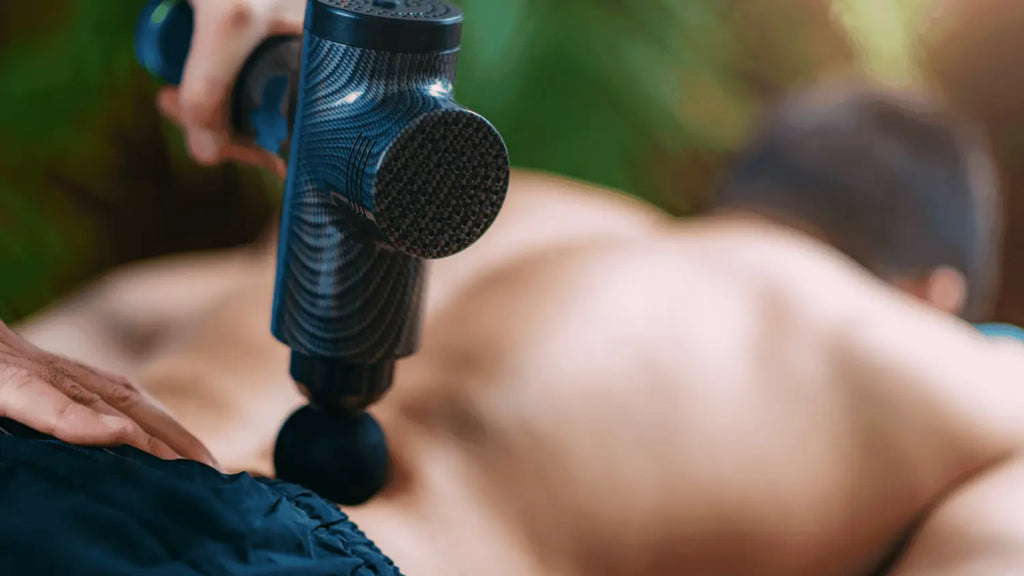
Signes indiquant qu'un nœud nécessite des soins médicaux
Bien que les pistolets de massage soient efficaces pour la plupart des nœuds, l'intervention d'un professionnel peut parfois s'avérer nécessaire. Si le nœud provoque une douleur intense ou irradie vers d'autres parties du corps, il peut être plus grave qu'un nœud musculaire classique.
Dans ces cas, il est recommandé de consulter un professionnel de la santé, comme un massothérapeute ou un physiothérapeute. Il pourra évaluer la cause sous-jacente du problème et proposer des options de traitement.
Combiner la thérapie par percussion avec d'autres traitements
Pour les nœuds persistants ou chroniques, combiner la thérapie par percussion avec des traitements comme les étirements, la physiothérapie ou le massage professionnel peut offrir les meilleurs résultats. Un professionnel de santé peut vous guider dans l'utilisation appropriée d'un pistolet de massage pendant votre processus de guérison.
Cette approche garantit que vous vous attaquez à la cause profonde des nœuds, plutôt qu’aux seuls symptômes, et empêche d’autres problèmes de se développer au fil du temps.
Conclusion : les pistolets de massage sont-ils efficaces contre les nœuds musculaires ?
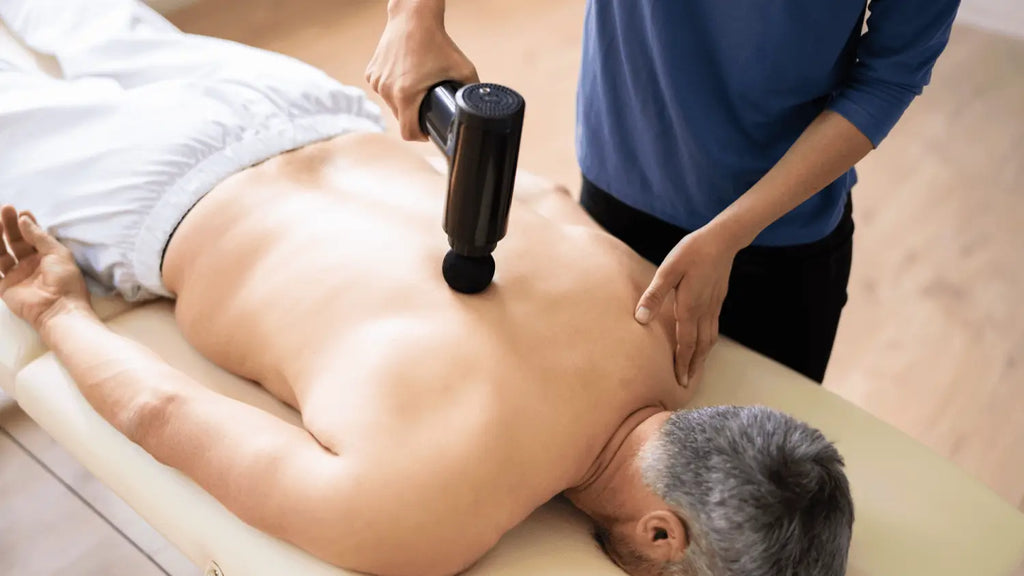
Les pistolets de massage sont très efficaces pour traiter les nœuds musculaires , procurant des bienfaits immédiats et à long terme. En détendant les fibres musculaires tendues, en augmentant la circulation sanguine et en favorisant la récupération, ils offrent une solution pratique aux tensions musculaires. Cependant, leur utilisation est essentielle.
Questions fréquemment posées
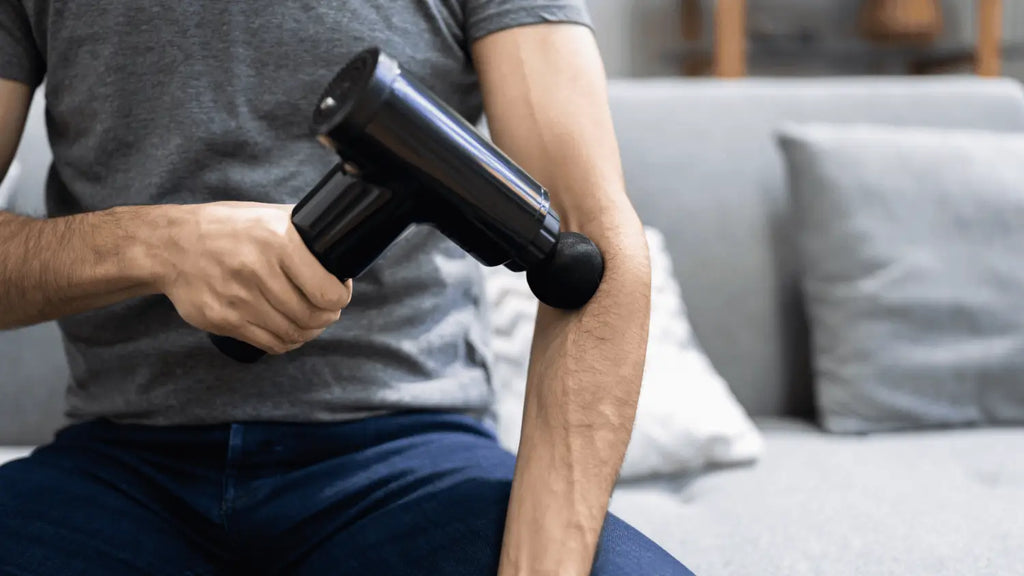
1. Les pistolets de massage fonctionnent-ils pour les nœuds musculaires ?
Oui, les pistolets de massage sont efficaces contre les nœuds musculaires . Ils utilisent la thérapie par percussion pour appliquer une pression profonde sur les tissus musculaires, dissipant ainsi les tensions et améliorant la circulation sanguine. Cette action aide à dénouer les nœuds et soulage les douleurs cervicales et autres inconforts musculaires.
Les pistolets de massage peuvent soulager les douleurs musculaires en relaxant les fibres tendues et en favorisant la récupération. Pour ceux qui se demandent « comment fonctionne un pistolet de massage », il cible les couches profondes des tissus par des mouvements rapides et répétitifs, ce qui en fait un pistolet musculaire puissant pour un usage domestique.
2. Comment les pistolets de massage aident-ils à soulager les nœuds musculaires ?
Les pistolets de massage aident à soulager les nœuds musculaires en délivrant des percussions ciblées sur la zone affectée , dissipant ainsi les tensions causées par l'exercice ou une mauvaise posture. Les impulsions rapides améliorent la circulation et réduisent les tensions. Les pistolets de massage soulagent les tensions musculaires et favorisent le soulagement des courbatures.
Ils ne remplacent pas totalement les traitements professionnels, mais leur utilisation régulière peut considérablement résoudre les problèmes avant qu'ils ne deviennent chroniques. Il est essentiel de lire attentivement les instructions pour comprendre comment utiliser efficacement la thérapie par pistolet de massage.
3. Les pistolets de massage sont-ils bons pour les nœuds dans le dos et les épaules ?
Les pistolets de massage sont efficaces pour soulager les tensions du dos et des épaules. Ces zones sont sujettes aux tensions dues au stress ou à une position assise prolongée. Un pistolet de massage vous permet de cibler ces grands groupes musculaires et de les soulager.
Utiliser un accessoire de massage musculaire adapté, comme une tête ronde, permet de soulager les tensions sans provoquer d'irritation. N'oubliez pas d'intégrer des étirements doux à votre routine : les pistolets de massage peuvent soulager les courbatures, mais sont plus efficaces en combinaison avec des exercices de mobilité.
4. Quel est le meilleur accessoire pour utiliser un pistolet de massage sur les nœuds musculaires ?
Les bienfaits des pistolets de massage dépendent grandement de l'utilisation d'un accessoire adapté. Pour les nœuds profonds, un embout en forme de balle ou de fourche est idéal , tandis qu'un embout rond est idéal pour les zones plus larges comme le dos ou les jambes. Ces accessoires aident les pistolets de massage à soulager en ciblant efficacement les zones à problèmes.
La bonne technique d'utilisation d'un pistolet de massage consiste à le déplacer lentement autour du nœud en appliquant une pression modérée. Cette approche maximise les bienfaits de la thérapie par pistolet tout en évitant les tensions musculaires supplémentaires.
5. À quelle fréquence devez-vous utiliser un pistolet de massage sur les nœuds musculaires ?
Utiliser un pistolet de massage 2 à 3 fois par semaine sur chaque nœud est idéal. Cette fréquence permet aux muscles de récupérer sans les solliciter excessivement. Des séances régulières sont essentielles pour maintenir la santé musculaire, surtout après les entraînements, qui peuvent provoquer des courbatures.
Si vous pratiquez une activité physique régulière, un masseur musculaire peut favoriser la récupération post-effort. Pour apprendre à utiliser efficacement un pistolet de massage, commencez par des vitesses faibles et augmentez progressivement l'intensité pour obtenir de meilleurs résultats sans effort excessif.
6. Combien de temps faut-il à un pistolet de massage pour agir sur les nœuds ?
Il suffit généralement d'une à deux minutes d'utilisation d'un pistolet de massage sur un nœud spécifique pour ressentir un soulagement. La thérapie par percussion rapide détend les fibres musculaires, augmente la circulation sanguine et réduit les tensions.
Les bienfaits de la thérapie par percussion s'accentuent avec une utilisation régulière, notamment après l'effort, lorsque les muscles sont tendus. Pour garantir des bénéfices à long terme, associez la thérapie par pistolet de massage à des exercices d'étirement et de mobilité afin de prévenir la réapparition des nœuds.
7. Les pistolets de massage peuvent-ils remplacer le massage des tissus profonds pour les nœuds ?
Les pistolets de massage constituent une alternative efficace au massage des tissus profonds, mais ne remplacent pas totalement les traitements professionnels . Ils peuvent soulager rapidement les douleurs cervicales ou les tensions musculaires à domicile, notamment pour les personnes pratiquant une activité physique régulière.
Bien que les pistolets de massage soulagent efficacement les tensions musculaires, ils ne pénètrent pas aussi profondément qu'un massage manuel effectué par un thérapeute. Pour les personnes souffrant de problèmes chroniques, il est préférable d'utiliser les pistolets de massage en complément d'autres traitements pour des résultats optimaux.
8. Les pistolets de massage sont-ils meilleurs que le rouleau en mousse pour les nœuds musculaires ?
Les pistolets de massage peuvent soulager les douleurs musculaires plus efficacement que le rouleau en mousse pour cibler des nœuds spécifiques. Si les rouleaux en mousse sont efficaces pour soulager les tensions générales, les pistolets de massage exercent une pression plus ciblée grâce à la thérapie par percussion.
Ils sont donc idéaux pour détendre les fibres musculaires tendues dans des zones localisées. De plus, l'utilisation d'un pistolet de massage permet une pénétration plus profonde des tissus, particulièrement utile après une séance d'entraînement ou pour les personnes restant assises pendant de longues périodes.
9. Les pistolets de massage peuvent-ils endommager les muscles s'ils sont utilisés sur des nœuds ?
Utilisés correctement, les pistolets de massage sont sûrs , mais une mauvaise utilisation peut entraîner des problèmes. Une pression excessive ou une utilisation prolongée de l'appareil peut provoquer des ecchymoses ou aggraver le nœud. Pour éviter ces risques, il est essentiel de comprendre comment utiliser correctement un pistolet de massage et de commencer par des réglages faibles.
Les pistolets de massage sont sans danger pour les tissus conjonctifs s'ils sont utilisés avec précaution et associés à des exercices d'étirement et de récupération appropriés. En cas d'inquiétude, consultez un professionnel de santé ou de santé publique.
10. Quelle est la meilleure façon d’utiliser un pistolet de massage pour les nœuds musculaires ?
La meilleure façon d'utiliser un pistolet de massage est de déplacer l'appareil doucement autour du nœud, en exerçant une pression modérée . Commencez à faible vitesse et augmentez progressivement l'intensité à mesure que le nœud se desserre. Utiliser l'accessoire approprié est essentiel pour maximiser les bienfaits du massage par pistolet.
Lorsque vous ciblez des nœuds spécifiques, comme ceux du cou ou des épaules, lisez attentivement les instructions pour une utilisation sûre et efficace. Une utilisation appropriée d'un pistolet de massage peut soulager considérablement les tensions musculaires et procurer un soulagement durable.


